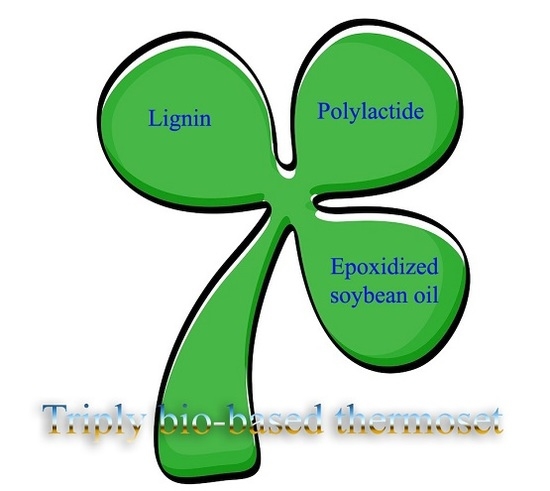Triply Biobased Thermoplastic Composites of Polylactide/Succinylated Lignin/Epoxidized Soybean Oil
Abstract
1. Introduction
2. Materials and Methods
2.1. Materials
2.2. Synthesis of Succinylated Lignin Adducts
2.3. Dynamic Vulcanization of ESO and SAL with PLA
2.4. Preparation of Composites
2.5. Characterization and Measurements
2.5.1. Fourier Transform Infrared Spectroscopy
2.5.2. Nuclear Magnetic Resonance Spectroscopy
2.5.3. Dynamic Mechanical Analysis
2.5.4. Differential Scanning Calorimetry
2.5.5. Thermogravimetric Analysis
2.5.6. Rheological Analysis
2.5.7. Mechanical Properties
2.5.8. Scanning Electron Microscopy
3. Results and Discussion
3.1. The Characterization of SAL Adducts
3.2. Processing and Rheological Behaviors
3.3. Dynamic Mechanical Analysis
3.4. Melting and Crystallization Behaviors
3.5. Thermal Stability
3.6. Mechanical Properties
4. Conclusions
Author Contributions
Acknowledgments
Conflicts of Interest
References
- Ragauskas, A.; Beckham, G.T.; Biddy, M.J.; Chandra, R.; Chen, F.; Davis, M.; Davison, B.H.; Dixon, R.A.; Gilna, P.; Keller, M.; et al. Lignin Valorization: Improving Lignin Processing in the Biorefinery. Science 2014, 344, 1246843. [Google Scholar] [CrossRef] [PubMed]
- Melero, J.A.; Iglesias, J.; García, A. Biomass as renewable feedstock in standard refinery units. Feasibility, opportunities and challenges. Energy Environ. Sci. 2012, 5, 7393. [Google Scholar] [CrossRef]
- Serrano-Ruiz, J.C.; Dumesic, J.A. Catalytic routes for the conversion of biomass into liquid hydrocarbon transportation fuels. Energy Environ. Sci. 2011, 4, 83–99. [Google Scholar] [CrossRef]
- Zhou, C.-H.; Xia, X.; Lin, C.-X.; Tong, D.-S.; Beltramini, J. Catalytic conversion of lignocellulosic biomass to fine chemicals and fuels. Chem. Soc. Rev. 2011, 40, 5588. [Google Scholar] [CrossRef] [PubMed]
- Bai, H.; Xiu, H.; Gao, J.; Deng, H.; Zhang, Q.; Yang, M.; Fu, Q. Tailoring Impact Toughness of Poly(l-lactide)/Poly(ε-caprolactone) (PLLA/PCL) Blends by Controlling Crystallization of PLLA Matrix. ACS Appl. Mater. Interfaces 2012, 4, 897–905. [Google Scholar] [CrossRef]
- Chen, G.-Q.; Patel, M.K. Plastics Derived from Biological Sources: Present and Future: A Technical and Environmental Review. Chem. Rev. 2011, 112, 2082–2099. [Google Scholar] [CrossRef]
- Gandini, A.; Lacerda, T.M. From monomers to polymers from renewable resources: Recent advances. Prog. Polym. Science 2015, 48, 1–39. [Google Scholar] [CrossRef]
- Zhou, S.; Huang, H.-D.; Xu, L.; Yan, Z.; Zhong, G.-J.; Hsiao, B.S.; Li, Z.-M. In Situ Nanofibrillar Networks Composed of Densely Oriented Polylactide Crystals as Efficient Reinforcement and Promising Barrier Wall for Fully Biodegradable Poly(butylene succinate) Composite Films. ACS Sustain. Chem. Eng. 2016, 4, 2887–2897. [Google Scholar] [CrossRef]
- Kloekhorst, A.; Heeres, H. Catalytic hydrotreatment of Alcell lignin fractions using a Ru/C catalyst. Catal. Sci. Technol. 2016, 6, 7053–7067. [Google Scholar] [CrossRef]
- No, S.-Y. Application of bio-oils from lignocellulosic biomass to transportation, heat and power generation—A review. Renew. Sustain. Energy Rev. 2014, 40, 1108–1125. [Google Scholar] [CrossRef]
- Zhou, X.; Zheng, F.; Lv, C.; Tang, L.; Wei, K.; Liu, X.; Du, G.; Yong, Q.; Xue, G. Properties of formaldehyde-free environmentally friendly lignocellulosic composites made from poplar fibres and oxygen-plasma-treated enzymatic hydrolysis lignin. Compos. Part B Eng. 2013, 53, 369–375. [Google Scholar] [CrossRef]
- Cannatelli, M.D.; Ragauskas, A. Conversion of lignin into value-added materials and chemicals via laccase-assisted copolymerization. Appl. Microbiol. Biotechnol. 2016, 100, 8685–8691. [Google Scholar] [CrossRef] [PubMed]
- Gil, B.M.; Song, S.W.; Lee, J.H.; Jeon, J.; Lee, K.H.; Wie, J.J. Introduction of primary chemical bonding in lignin-based PP composites for mechanical reinforcement via reactive extrusion. Compos. Part B Eng. 2019, 165, 510–515. [Google Scholar] [CrossRef]
- Laurichesse, S.; Avérous, L. Chemical modification of lignins: Towards biobased polymers. Prog. Polym. Sci. 2014, 39, 1266–1290. [Google Scholar] [CrossRef]
- Jayaramudu, T.; Ko, H.-U.; Kim, H.C.; Kim, J.W.; Choi, E.S.; Kim, J. Adhesion properties of poly(ethylene oxide)-lignin blend for nanocellulose composites. Compos. Part B Eng. 2019, 156, 43–50. [Google Scholar] [CrossRef]
- Yeo, J.-S.; Lee, J.; Hwang, S.-H. Effects of lignin on the volume shrinkage and mechanical properties of a styrene/unsaturated polyester/lignin ternary composite system. Compos. Part B Eng. 2017, 130, 167–173. [Google Scholar] [CrossRef]
- Fernandes, E.; Aroso, I.; Mano, J.F.; Covas, J.A.; Reis, R.L. Functionalized cork-polymer composites (CPC) by reactive extrusion using suberin and lignin from cork as coupling agents. Compos. Part B Eng. 2014, 67, 371–380. [Google Scholar] [CrossRef]
- Constant, S.; Wienk, H.; Frissen, A.E.; De Peinder, P.; Boelens, R.; Van Es, D.S.; Grisel, R.J.H.; Weckhuysen, B.M.; Huijgen, W.; Gosselink, R.; et al. New insights into the structure and composition of technical lignins: A comparative characterisation study. Green Chem. 2016, 18, 2651–2665. [Google Scholar] [CrossRef]
- Yan, L.; Cui, Y.; Gou, G.; Wang, Q.; Jiang, M.; Zhang, S.; Hui, D.; Gou, J.; Zhou, Z. Liquefaction of lignin in hot-compressed water to phenolic feedstock for the synthesis of phenol-formaldehyde resins. Compos. Part B Eng. 2017, 112, 8–14. [Google Scholar] [CrossRef]
- Liu, Y.; Wang, L.; He, Y.; Fan, Z.; Li, S. Non-isothermal crystallization kinetics of poly(L-lactide). Polym. Int. 2010, 59, 1616–1621. [Google Scholar] [CrossRef]
- Pilla, S.; Kramschuster, A.; Lee, J.; Clemons, C.; Gong, S.; Turng, L.-S. Microcellular processing of polylactide–hyperbranched polyester–nanoclay composites. J. Mater. Sci. 2010, 45, 2732–2746. [Google Scholar] [CrossRef]
- Jamshidian, M.; Tehrany, E.A.; Imran, M.; Akhtar, M.J.; Cleymand, F.; Desobry, S. Structural, mechanical and barrier properties of active PLA–antioxidant films. J. Food Eng. 2012, 110, 380–389. [Google Scholar] [CrossRef]
- Güner, F.S.; Yagci, Y.; Erciyes, A.T. Polymers from triglyceride oils. Prog. Polym. Sci. 2006, 31, 633–670. [Google Scholar] [CrossRef]
- Chen, Y.; Yuan, D.; Xu, C. Dynamically Vulcanized Biobased Polylactide/Natural Rubber Blend Material with Continuous Cross-Linked Rubber Phase. ACS Appl. Mater. Interfaces 2014, 6, 3811–3816. [Google Scholar] [CrossRef]
- Lebarbé, T.; Grau, E.; Gadenne, B.; Alfos, C.; Cramail, H. Synthesis of Fatty Acid-Based Polyesters and Their Blends with Poly(l-lactide) as a Way To Tailor PLLA Toughness. ACS Sustain. Chem. Eng. 2014, 3, 283–292. [Google Scholar] [CrossRef]
- Ock, H.G.; Ahn, K.H.; Lee, S.J.; Hyun, K. Characterization of Compatibilizing Effect of Organoclay in Poly(lactic acid) and Natural Rubber Blends by FT-Rheology. Macromolecules 2016, 49, 2832–2842. [Google Scholar] [CrossRef]
- Wang, M.; Wu, Y.; Li, Y.-D.; Zeng, J.-B. Progress in Toughening Poly(Lactic Acid) with Renewable Polymers. Polym. Rev. 2017, 57, 557–593. [Google Scholar] [CrossRef]
- Yuan, D.; Chen, Z.; Xu, C.; Chen, K.; Chen, Y. Fully Biobased Shape Memory Material Based on Novel Cocontinuous Structure in Poly(Lactic Acid)/Natural Rubber TPVs Fabricated via Peroxide-Induced Dynamic Vulcanization and in Situ Interfacial Compatibilization. ACS Sustain. Chem. Eng. 2015, 3, 2856–2865. [Google Scholar] [CrossRef]
- Zolali, A.M.; Heshmati, V.; Favis, B.D. Ultratough Co-Continuous PLA/PA11 by Interfacially Percolated Poly(ether-b-amide). Macromolecules 2016, 50, 264–274. [Google Scholar] [CrossRef]
- Chang, K.; Robertson, M.L.; Hillmyer, M.A. Phase Inversion in Polylactide/Soybean Oil Blends Compatibilized by Poly(isoprene-b-lactide) Block Copolymers. ACS Appl. Mater. Interfaces 2009, 1, 2390–2399. [Google Scholar] [CrossRef]
- Robertson, M.L.; Paxton, J.M.; Hillmyer, M.A. Tough Blends of Polylactide and Castor Oil. ACS Appl. Mater. Interfaces 2011, 3, 3402–3410. [Google Scholar] [CrossRef] [PubMed]
- Liu, G.-C.; He, Y.-S.; Zeng, J.-B.; Li, Q.-T.; Wang, Y.-Z. Fully Biobased and Supertough Polylactide-Based Thermoplastic Vulcanizates Fabricated by Peroxide-Induced Dynamic Vulcanization and Interfacial Compatibilization. Biomacromolecules 2014, 15, 4260–4271. [Google Scholar] [CrossRef] [PubMed]
- Liu, G.-C.; He, Y.-S.; Zeng, J.-B.; Xu, Y.; Wang, Y.-Z. In situ formed crosslinked polyurethane toughened polylactide. Polym. Chem. 2014, 5, 2530. [Google Scholar] [CrossRef]
- Liu, H.; Chen, F.; Liu, B.; Estep, G.; Zhang, J. Super Toughened Poly(lactic acid) Ternary Blends by Simultaneous Dynamic Vulcanization and Interfacial Compatibilization. Macromolecules 2010, 43, 6058–6066. [Google Scholar] [CrossRef]
- Liu, H.; Song, W.; Chen, F.; Guo, L.; Zhang, J. Interaction of Microstructure and Interfacial Adhesion on Impact Performance of Polylactide (PLA) Ternary Blends. Macromolecules 2011, 44, 1513–1522. [Google Scholar] [CrossRef]
- Banerjee, S.S.; Bhowmick, A.K. High-temperature thermoplastic elastomers from rubber–plastic blends: A state-of-the-art review. Rubber Chem. Technol. 2017, 90, 1–36. [Google Scholar] [CrossRef]
- España, J.M.; Sánchez-Nacher, L.; Boronat, T.; Fombuena, V.; Balart, R. Properties of Biobased Epoxy Resins from Epoxidized Soybean Oil (ESBO) Cured with Maleic Anhydride (MA). J. Am. Oil Chem. Soc. 2012, 89, 2067–2075. [Google Scholar] [CrossRef]
- Shibata, M.; Teramoto, N.; Makino, K. Preparation and properties of biocomposites composed of epoxidized soybean oil, tannic acid, and microfibrillated cellulose. J. Appl. Polym. Sci. 2010, 120, 273–278. [Google Scholar] [CrossRef]
- Scarica, C.; Suriano, R.; Levi, M.; Turri, S.; Griffini, G. Lignin Functionalized with Succinic Anhydride as Building Block for Biobased Thermosetting Polyester Coatings. ACS Sustain. Chem. Eng. 2018, 6, 3392–3401. [Google Scholar] [CrossRef]
- Zhao, T.-H.; Wu, Y.; Li, Y.-D.; Wang, M.; Zeng, J.-B. High Performance and Thermal Processable Dicarboxylic Acid Cured Epoxidized Plant Oil Resins through Dynamic Vulcanization with Poly(lactic acid). ACS Sustain. Chem. Eng. 2017, 5, 1938–1947. [Google Scholar] [CrossRef]
- Yang, L.; Yang, Z.; Zhang, F.; Xie, L.; Luo, Z.; Zheng, Q. Star Shaped Long Chain Branched Poly (lactic acid) Prepared by Melt Transesterification with Trimethylolpropane Triacrylate and Nano-ZnO. Polymer 2018, 10, 796. [Google Scholar] [CrossRef] [PubMed]
- Huang, A.; Peng, X.; Turng, L.-S. In-situ fibrillated polytetrafluoroethylene (PTFE) in thermoplastic polyurethane (TPU) via melt blending: Effect on rheological behavior, mechanical properties, and microcellular foamability. Polymer 2018, 134, 263–274. [Google Scholar] [CrossRef]
- Luo, S.; Cao, J.; McDonald, A.G. Esterification of industrial lignin and its effect on the resulting poly(3-hydroxybutyrate-co-3-hydroxyvalerate) or polypropylene blends. Ind. Crop. Prod. 2017, 97, 281–291. [Google Scholar] [CrossRef]
- Thunga, M.; Chen, K.; Grewell, D.; Kessler, M.R. Bio-renewable precursor fibers from lignin/polylactide blends for conversion to carbon fibers. Carbon 2014, 68, 159–166. [Google Scholar] [CrossRef]
- Costes, L.; Laoutid, F.; Brohez, S.; Delvosalle, C.; Dubois, P. Phytic acid–lignin combination: A simple and efficient route for enhancing thermal and flame retardant properties of polylactide. Eur. Polym. J. 2017, 94, 270–285. [Google Scholar] [CrossRef]
- Prieur, B.; Meub, M.; Wittemann, M.; Klein, R.; Bellayer, S.; Fontaine, G.; Bourbigot, S. Phosphorylation of lignin to flame retard acrylonitrile butadiene styrene (ABS). Polym. Degrad. Stab. 2016, 127, 32–43. [Google Scholar] [CrossRef]
- Sahoo, S.; Misra, M.; Andrzejewski, J. Effect of compatibilizer and fillers on the properties of injection molded lignin-based hybrid green composites. J. Appl. Polym. Sci. 2012, 127, 4110–4121. [Google Scholar] [CrossRef]
- Li, J.; He, Y.; Inoue, Y. Thermal and mechanical properties of biodegradable blends of poly(L-lactic acid) and lignin. Polym. Int. 2003, 52, 949–955. [Google Scholar] [CrossRef]
- Ouyang, W.; Huang, Y.; Luo, H.; Wang, D. Poly(Lactic Acid) Blended with Cellulolytic Enzyme Lignin: Mechanical and Thermal Properties and Morphology Evaluation. J. Polym. Environ. 2011, 20, 1–9. [Google Scholar] [CrossRef]
- Abdelwahab, M.A.; Taylor, S.; Misra, M.; Andrzejewski, J. Thermo-mechanical characterization of bioblends from polylactide and poly(butylene adipate-co-terephthalate) and lignin. Macromol. Mater. Eng. 2015, 300, 299–311. [Google Scholar] [CrossRef]

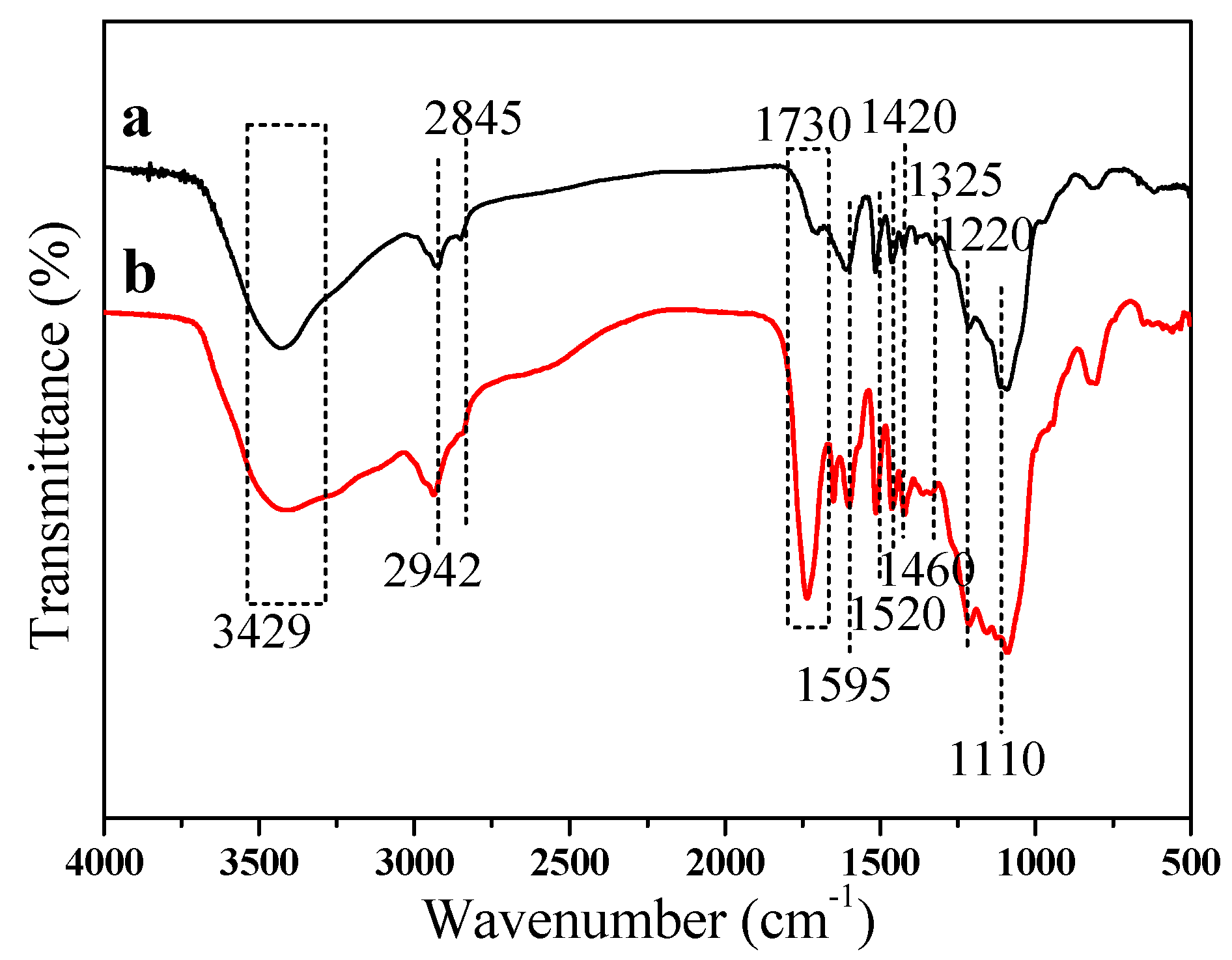

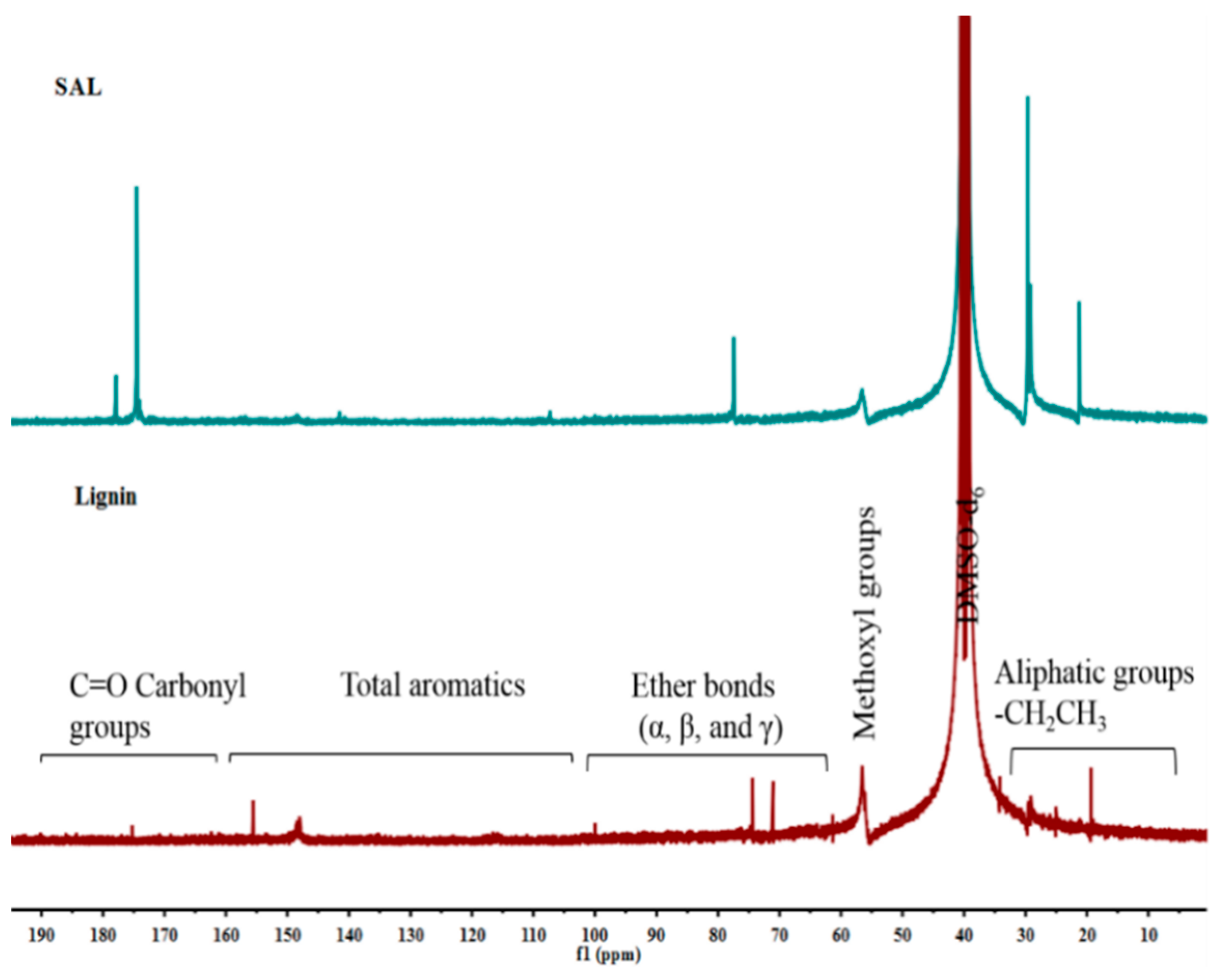
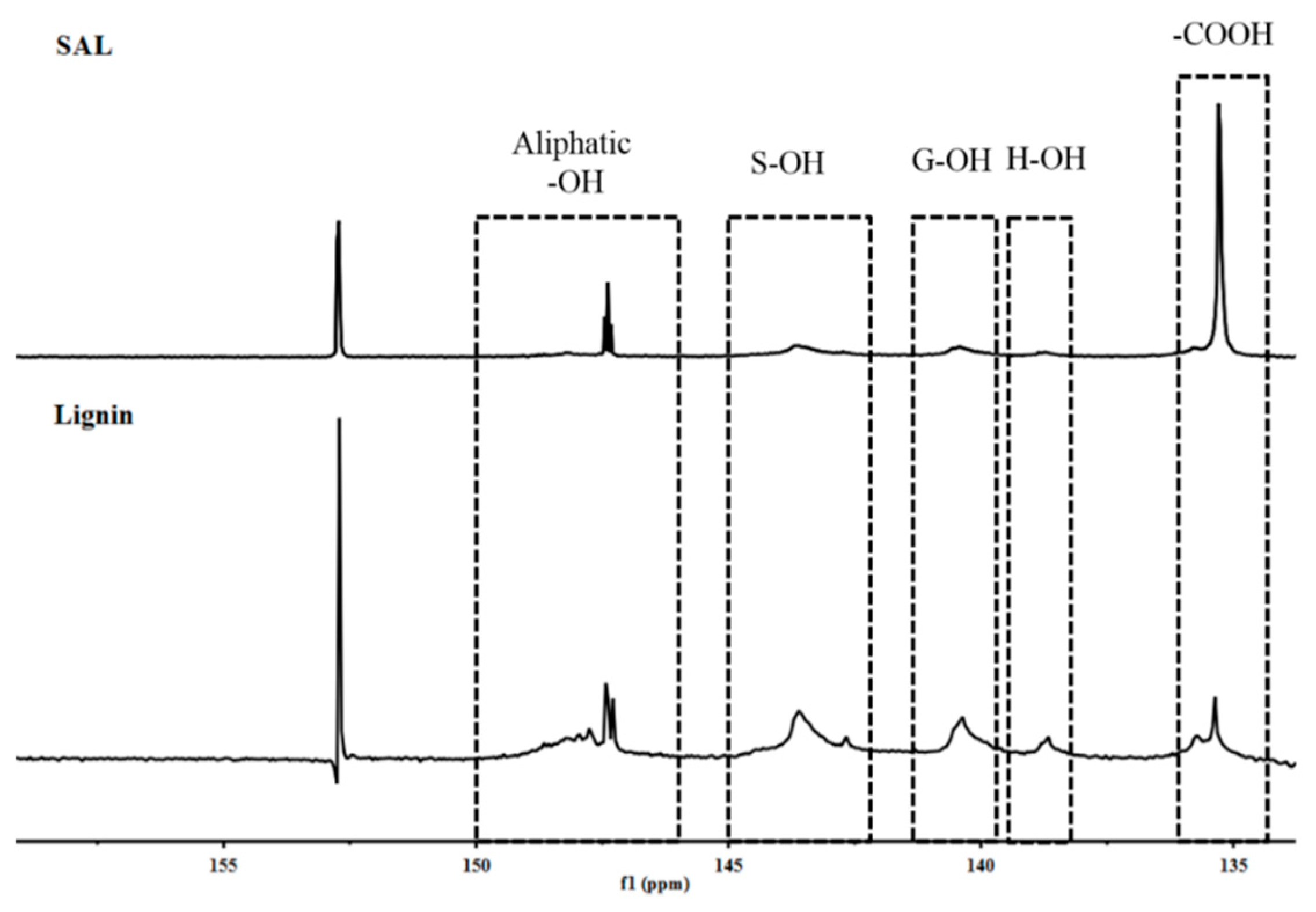

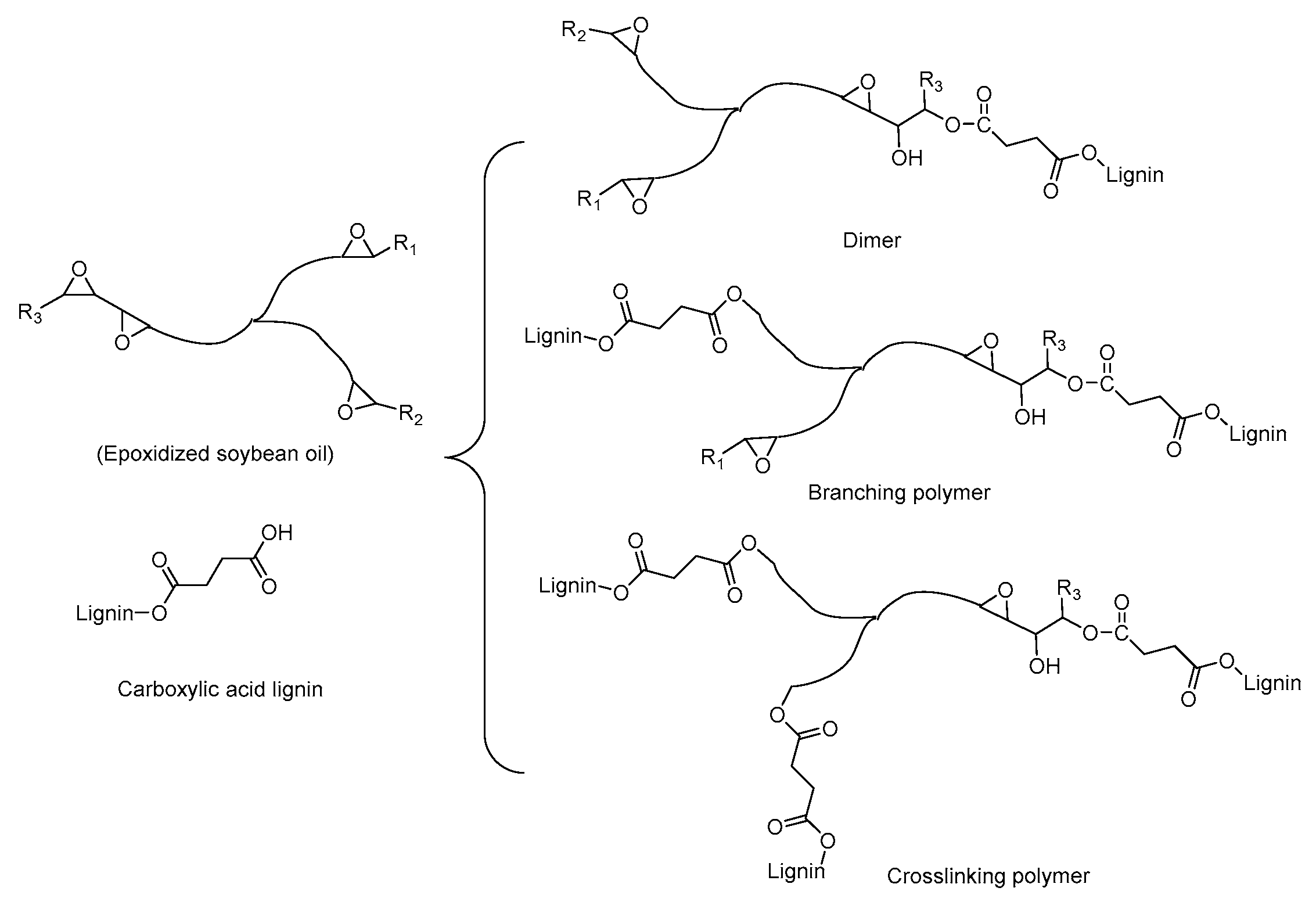

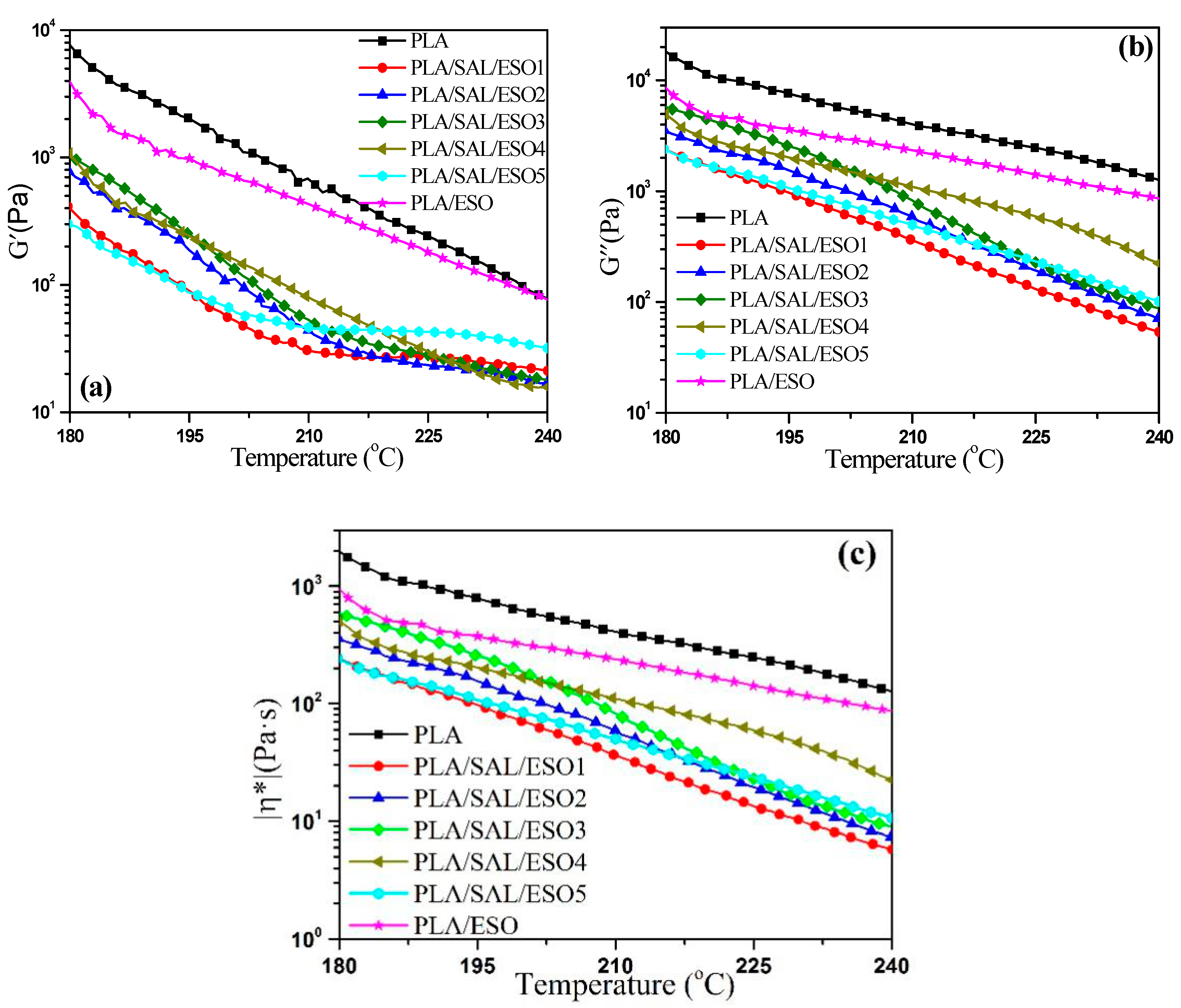



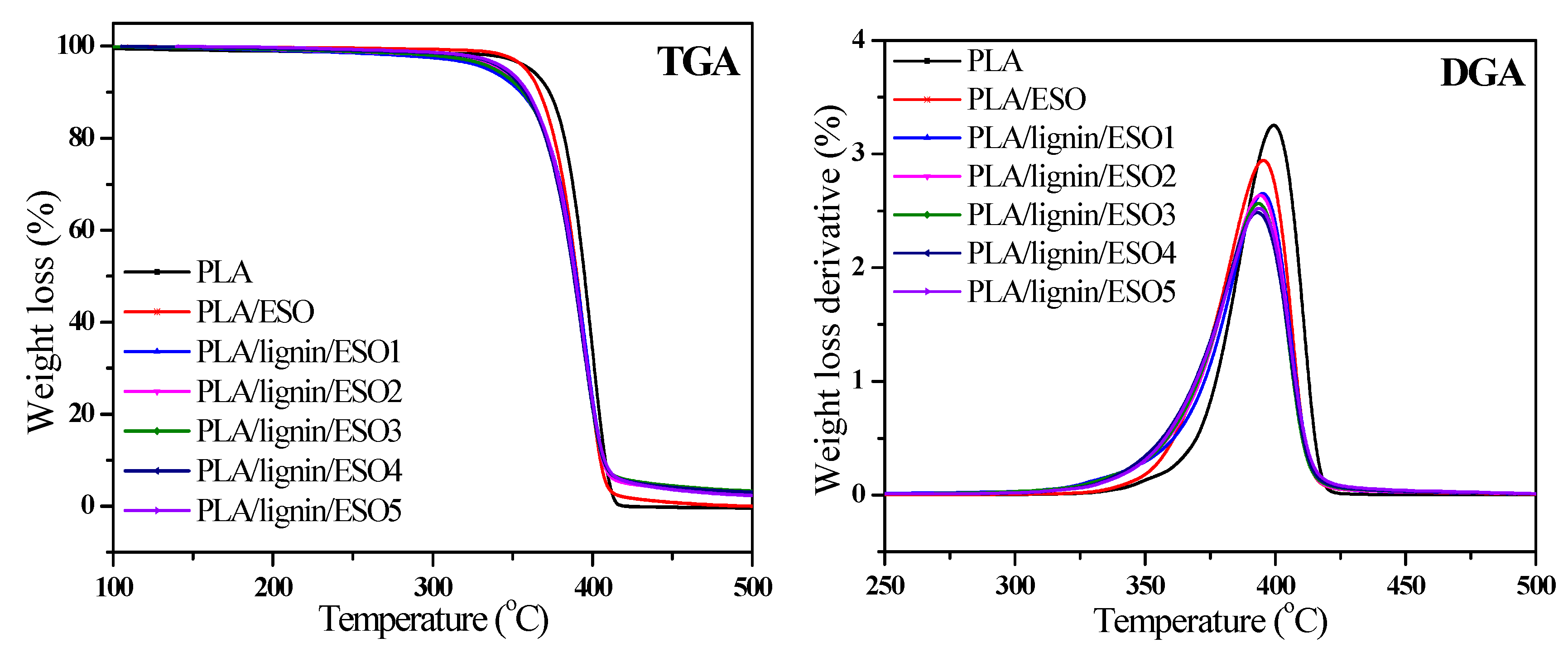
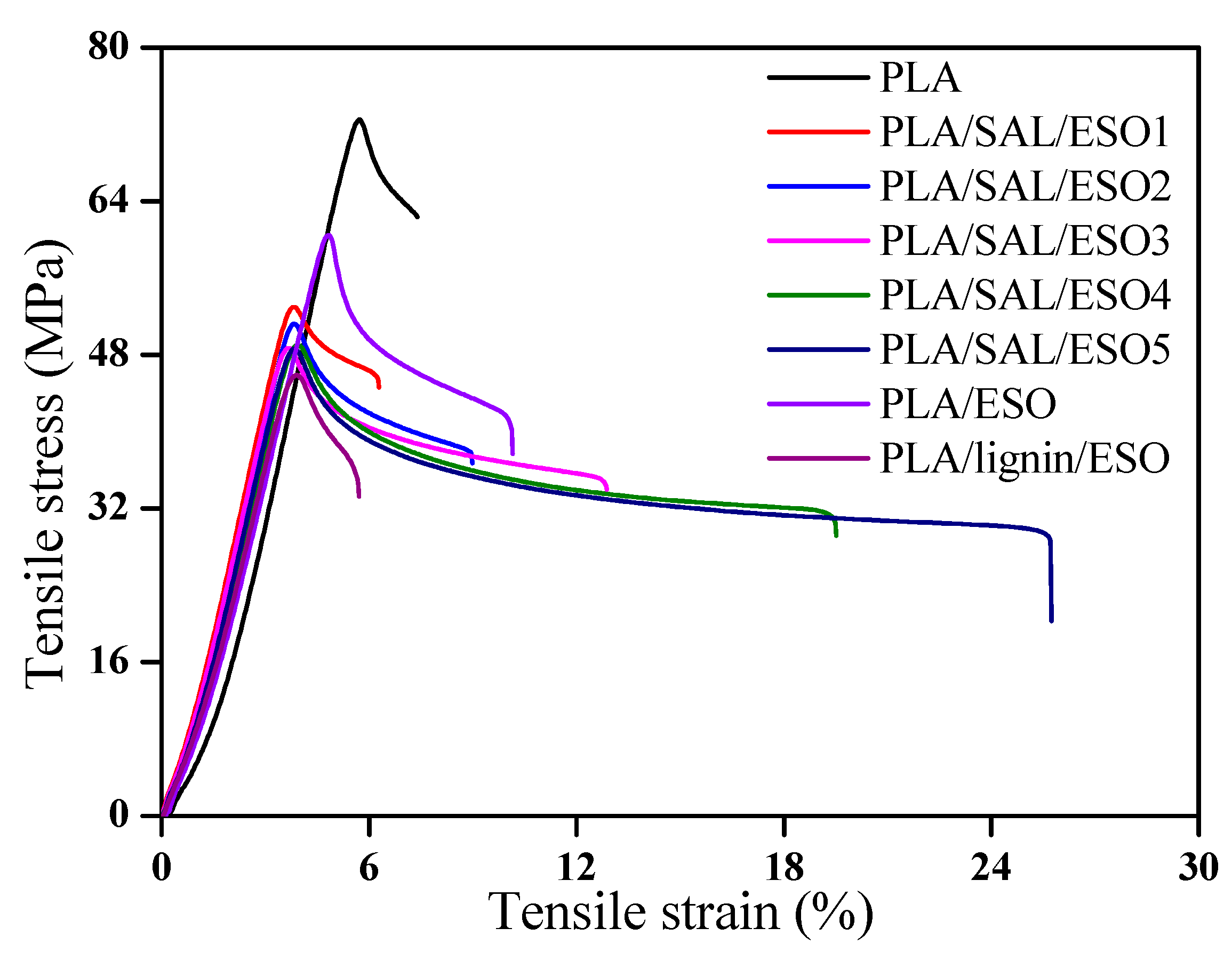
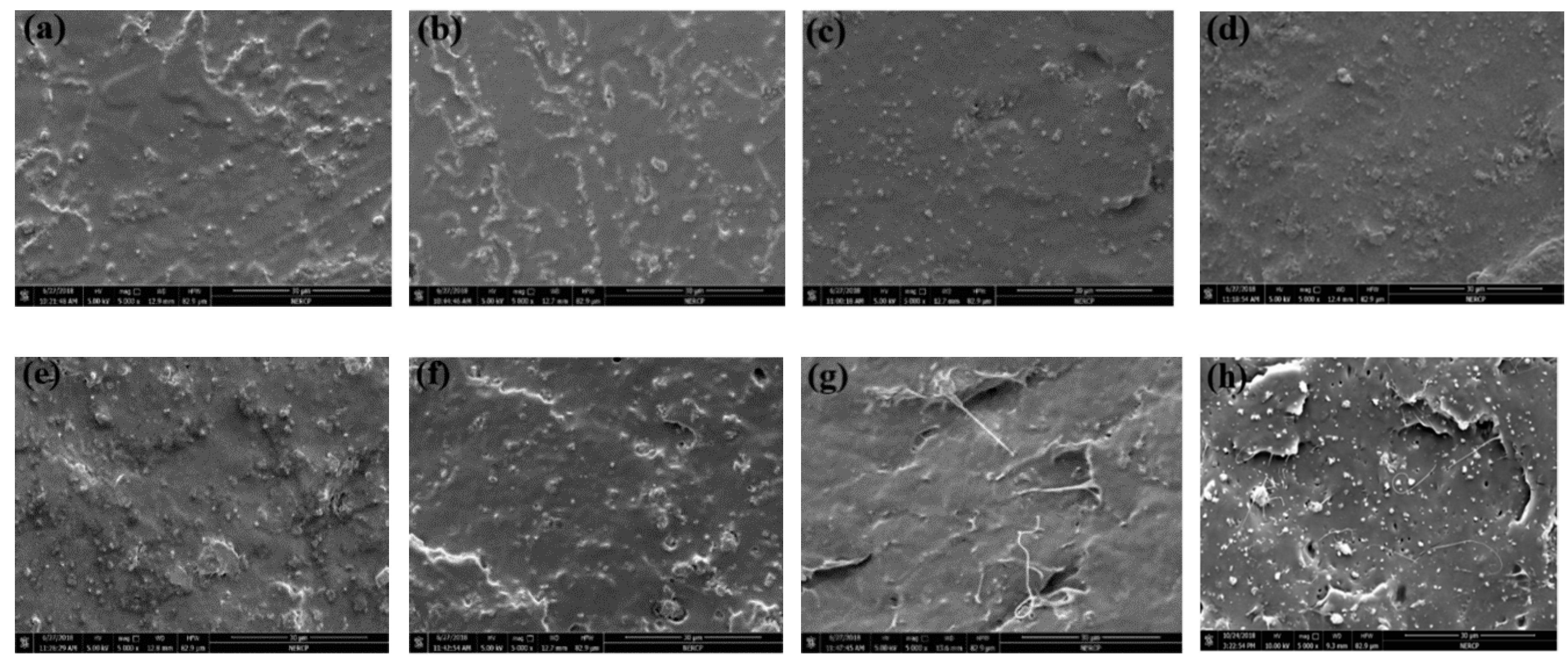
| Entry | PLA (%) | SAL (%) | ESO (%) |
|---|---|---|---|
| PLA | 100 | 0 | 0 |
| PLA/SAL/ESO1 | 93 | 5 | 2 |
| PLA/SAL/ESO2 | 92 | 5 | 3 |
| PLA/SAL/ESO3 | 91 | 5 | 4 |
| PLA/SAL/ESO4 | 90 | 5 | 5 |
| PLA/SAL/ESO5 | 89 | 5 | 6 |
| PLA/ESO | 94 | 0 | 6 |
| PLA/lignin/ESO | 90 | 5 | 5 |
| Functional Groups | Acidified Lignin (mmolg−1) | Carboxyl Lignin (mmolg−1) |
|---|---|---|
| Aliphatic-OH | 1.182 | 0.321 |
| S [a]-OH | 1.684 | 0.818 |
| G [b]-OH | 1.077 | 0.509 |
| H [c]-OH | 0.188 | 0.152 |
| -COOH | 0.539 | 4.509 |
| total | 4.67 | 6.309 |
| Entry | Tg (°C) | Tc (°C) | Tm (°C) |
|---|---|---|---|
| PLA | 63.1 | 108.4 | 168.9 |
| PLA/ESO | 60.3 | 102.2 | 167.4 |
| PLA/SAL/ESO1 | 61.6 | 103.3 | 167.6 |
| PLA/SAL/ESO2 | 61.5 | 101.1 | 167.6 |
| PLA/SAL/ESO3 | 60.5 | 101.1 | 167.5 |
| PLA/SAL/ESO4 | 60.1 | 101.4 | 167.1 |
| PLA/SAL/ESO5 | 59.9 | 102.3 | 167.0 |
| Entry | T5% (°C) | Tmax (°C) | Residues at 500 °C (%) |
|---|---|---|---|
| PLA | 360.7 | 399.4 | 0 |
| PLA/ESO | 358.1 | 395.4 | 0 |
| PLA/SAL/ESO1 | 337.4 | 395.1 | 3.3 |
| PLA/SAL/ESO2 | 342.3 | 394.2 | 2.9 |
| PLA/SAL/ESO3 | 338.6 | 393.6 | 3.3 |
| PLA/SAL/ESO4 | 334.3 | 393.1 | 3.1 |
| PLA/SAL/ESO5 | 345.9 | 393.8 | 2.3 |
| Entry | Tensile Strength (MPa) | Elongation at Break (%) | Flexural Strength (MPa) | Flexural Modulus (MPa) | Notched Impact Strength (kJ/m2) |
|---|---|---|---|---|---|
| PLA | 72.5 ± 1.2 | 6 ± 0.5 | 102.3 ± 2.3 | 3123 ± 80 | 3.5 ± 0.2 |
| PLA/SAL/ESO1 | 54.5 ± 0.5 | 5 ± 0.6 | 90.8 ± 2.0 | 3171 ± 75 | 3.6 ± 0.3 |
| PLA/SAL/ESO2 | 53.5 ± 0.8 | 8 ± 0.6 | 77.1 ± 1.9 | 3022 ± 56 | 4.1 ± 0.2 |
| PLA/SAL/ESO3 | 51.2 ± 0.5 | 13 ± 1.0 | 68.9 ± 1.8 | 2848 ± 83 | 4.3 ± 0.1 |
| PLA/SAL/ESO4 | 47.8 ± 0.6 | 15 ± 1.3 | 60.5 ± 2.3 | 2803 ± 79 | 4.8 ± 0.2 |
| PLA/SAL/ESO5 | 47.1 ± 0.5 | 17 ± 1.8 | 53.9 ± 2.1 | 2720 ± 72 | 4.3 ± 0.3 |
| PLA/ESO | 60.4 ± 1.3 | 9 ± 0.9 | 78.1 ± 2.4 | 2990 ± 58 | 4.1 ± 0.2 |
| PLA/lignin/ESO | 45.9 ± 0.5 | 5 ± 0.5 | 58.8 ± 1.3 | 2793 ± 49 | 4.0 ± 0.1 |
© 2020 by the authors. Licensee MDPI, Basel, Switzerland. This article is an open access article distributed under the terms and conditions of the Creative Commons Attribution (CC BY) license (http://creativecommons.org/licenses/by/4.0/).
Share and Cite
Guo, J.; Wang, J.; He, Y.; Sun, H.; Chen, X.; Zheng, Q.; Xie, H. Triply Biobased Thermoplastic Composites of Polylactide/Succinylated Lignin/Epoxidized Soybean Oil. Polymers 2020, 12, 632. https://doi.org/10.3390/polym12030632
Guo J, Wang J, He Y, Sun H, Chen X, Zheng Q, Xie H. Triply Biobased Thermoplastic Composites of Polylactide/Succinylated Lignin/Epoxidized Soybean Oil. Polymers. 2020; 12(3):632. https://doi.org/10.3390/polym12030632
Chicago/Turabian StyleGuo, Jianbing, Jian Wang, Yong He, Hui Sun, Xiaolang Chen, Qiang Zheng, and Haibo Xie. 2020. "Triply Biobased Thermoplastic Composites of Polylactide/Succinylated Lignin/Epoxidized Soybean Oil" Polymers 12, no. 3: 632. https://doi.org/10.3390/polym12030632
APA StyleGuo, J., Wang, J., He, Y., Sun, H., Chen, X., Zheng, Q., & Xie, H. (2020). Triply Biobased Thermoplastic Composites of Polylactide/Succinylated Lignin/Epoxidized Soybean Oil. Polymers, 12(3), 632. https://doi.org/10.3390/polym12030632




